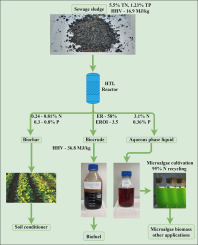当前位置:
X-MOL 学术
›
Sci. Total Environ.
›
论文详情
Our official English website, www.x-mol.net, welcomes your
feedback! (Note: you will need to create a separate account there.)
Energy recovery and nutrients recycling from municipal sewage sludge.
Science of the Total Environment ( IF 8.2 ) Pub Date : 2020-01-23 , DOI: 10.1016/j.scitotenv.2020.136775 Probir Das 1 , Shoyeb Khan 1 , Mohammed AbdulQuadir 1 , Mahmoud Thaher 1 , Muhammad Waqas 1 , Ahmed Easa 2 , Essam Shabaan Mohamed Attia 2 , Hareb Al-Jabri 1
Science of the Total Environment ( IF 8.2 ) Pub Date : 2020-01-23 , DOI: 10.1016/j.scitotenv.2020.136775 Probir Das 1 , Shoyeb Khan 1 , Mohammed AbdulQuadir 1 , Mahmoud Thaher 1 , Muhammad Waqas 1 , Ahmed Easa 2 , Essam Shabaan Mohamed Attia 2 , Hareb Al-Jabri 1
Affiliation

|
Hydrothermal Liquefaction (HTL) could be a promising and better alternative to other techniques for energy recovery from municipal sewage sludge (MSS). However, the nutrients (i.e., N, and P) recovery potential from the byproducts, generated in the HTL of MSS, needs to be studied so that a comprehensive sludge management practice could be adopted. In this study, HTL process temperature (275-400 °C), and reaction time (30-120 min) were first investigated for biocrude yield and release of the nutrients to the aqueous phase liquid (APL) and biochar. The maximum energy recovery (i.e., 59%) and maximum energy return on investment (i.e., 3.5) were obtained at 350 °C and 60 min of holding time. With the increase in HTL reaction time, the concentration of nitrogen in the APL increased (5.1 to 6.8 mg/L) while the concentration of phosphorus decreased (0.89 to 0.22 mg/L); the opposite was observed for the biochar. The nutrient recycling efficiency from the APL using microalgae was found to be strain-specific; nitrogen recycling efficiency by Picochlorum sp. and Chlorella sp. were 95.4 and 58.6%, respectively. The APL, derived from 1 kg MSS, could potentially produce 0.49 kg microalgal biomass. Since the concentrations of various metals in the biochar samples were substantially lower compared to their concentrations in raw MSS, the application of biochar as a soil conditioner could be very promising. Overall, net positive energy could be recovered from MSS using the HTL process, while the nutrients in the APL could be used to cultivate specific microalgae, and biochar could be applied to enhance the soil quality.
中文翻译:

从城市污水污泥中回收能量和养分。
水热液化(HTL)可能是一种有前途的,更好的替代方法,可以从市政污水污泥(MSS)中回收能量。但是,需要研究MSS HTL中从副产物中回收的养分(即N和P)潜力,以便可以采用全面的污泥管理实践。在这项研究中,首先研究了HTL工艺温度(275-400°C)和反应时间(30-120分钟)的生物粗品产率以及养分向水相液体(APL)和生物炭中的释放。在350°C和60分钟的保持时间下可获得最大的能量回收率(即59%)和最大的能量投资回报率(即3.5)。随着HTL反应时间的增加,APL中的氮浓度增加(5.1至6.8 mg / L),而磷浓度降低(0。89至0.22 mg / L);生物炭观察到相反的情况。发现使用微藻的APL产生的养分循环效率是特定菌株的。Picochlorum sp。的氮循环效率。和小球藻 分别为95.4和58.6%。源自1千克MSS的APL可能产生0.49千克微藻生物质。由于生物炭样品中各种金属的浓度远低于原始MSS中的浓度,因此将生物炭用作土壤改良剂可能非常有前途。总体而言,使用HTL工艺可从MSS中回收净正能量,而APL中的养分可用于种植特定的微藻,生物炭可用于提高土壤质量。发现使用微藻的APL产生的养分循环效率是特定菌株的。Picochlorum sp。的氮循环效率。和小球藻 分别为95.4和58.6%。源自1千克MSS的APL可能产生0.49千克微藻生物质。由于生物炭样品中各种金属的浓度远低于原始MSS中的浓度,因此将生物炭用作土壤改良剂可能非常有前途。总体而言,使用HTL工艺可从MSS中回收净正能量,而APL中的养分可用于种植特定的微藻,生物炭可用于提高土壤质量。发现使用微藻的APL产生的养分循环效率是特定菌株的。Picochlorum sp。的氮循环效率。和小球藻 分别为95.4和58.6%。源自1千克MSS的APL可能产生0.49千克微藻生物质。由于生物炭样品中各种金属的浓度远低于原始MSS中的浓度,因此将生物炭用作土壤改良剂可能非常有前途。总体而言,使用HTL工艺可从MSS中回收净正能量,而APL中的养分可用于种植特定的微藻,生物炭可用于提高土壤质量。分别为4和58.6%。源自1千克MSS的APL可能产生0.49千克微藻生物质。由于生物炭样品中各种金属的浓度远低于原始MSS中的浓度,因此将生物炭用作土壤改良剂可能非常有前途。总体而言,使用HTL工艺可从MSS中回收净正能量,而APL中的养分可用于种植特定的微藻,生物炭可用于提高土壤质量。分别为4和58.6%。源自1千克MSS的APL可能产生0.49千克微藻生物质。由于生物炭样品中各种金属的浓度远低于原始MSS中的浓度,因此将生物炭用作土壤改良剂可能非常有前途。总体而言,使用HTL工艺可从MSS中回收净正能量,而APL中的养分可用于种植特定的微藻,生物炭可用于提高土壤质量。
更新日期:2020-01-23
中文翻译:

从城市污水污泥中回收能量和养分。
水热液化(HTL)可能是一种有前途的,更好的替代方法,可以从市政污水污泥(MSS)中回收能量。但是,需要研究MSS HTL中从副产物中回收的养分(即N和P)潜力,以便可以采用全面的污泥管理实践。在这项研究中,首先研究了HTL工艺温度(275-400°C)和反应时间(30-120分钟)的生物粗品产率以及养分向水相液体(APL)和生物炭中的释放。在350°C和60分钟的保持时间下可获得最大的能量回收率(即59%)和最大的能量投资回报率(即3.5)。随着HTL反应时间的增加,APL中的氮浓度增加(5.1至6.8 mg / L),而磷浓度降低(0。89至0.22 mg / L);生物炭观察到相反的情况。发现使用微藻的APL产生的养分循环效率是特定菌株的。Picochlorum sp。的氮循环效率。和小球藻 分别为95.4和58.6%。源自1千克MSS的APL可能产生0.49千克微藻生物质。由于生物炭样品中各种金属的浓度远低于原始MSS中的浓度,因此将生物炭用作土壤改良剂可能非常有前途。总体而言,使用HTL工艺可从MSS中回收净正能量,而APL中的养分可用于种植特定的微藻,生物炭可用于提高土壤质量。发现使用微藻的APL产生的养分循环效率是特定菌株的。Picochlorum sp。的氮循环效率。和小球藻 分别为95.4和58.6%。源自1千克MSS的APL可能产生0.49千克微藻生物质。由于生物炭样品中各种金属的浓度远低于原始MSS中的浓度,因此将生物炭用作土壤改良剂可能非常有前途。总体而言,使用HTL工艺可从MSS中回收净正能量,而APL中的养分可用于种植特定的微藻,生物炭可用于提高土壤质量。发现使用微藻的APL产生的养分循环效率是特定菌株的。Picochlorum sp。的氮循环效率。和小球藻 分别为95.4和58.6%。源自1千克MSS的APL可能产生0.49千克微藻生物质。由于生物炭样品中各种金属的浓度远低于原始MSS中的浓度,因此将生物炭用作土壤改良剂可能非常有前途。总体而言,使用HTL工艺可从MSS中回收净正能量,而APL中的养分可用于种植特定的微藻,生物炭可用于提高土壤质量。分别为4和58.6%。源自1千克MSS的APL可能产生0.49千克微藻生物质。由于生物炭样品中各种金属的浓度远低于原始MSS中的浓度,因此将生物炭用作土壤改良剂可能非常有前途。总体而言,使用HTL工艺可从MSS中回收净正能量,而APL中的养分可用于种植特定的微藻,生物炭可用于提高土壤质量。分别为4和58.6%。源自1千克MSS的APL可能产生0.49千克微藻生物质。由于生物炭样品中各种金属的浓度远低于原始MSS中的浓度,因此将生物炭用作土壤改良剂可能非常有前途。总体而言,使用HTL工艺可从MSS中回收净正能量,而APL中的养分可用于种植特定的微藻,生物炭可用于提高土壤质量。











































 京公网安备 11010802027423号
京公网安备 11010802027423号